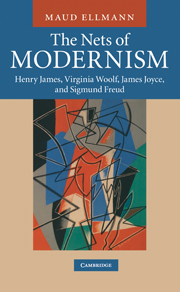Book contents
- Frontmatter
- Contents
- Acknowledgements
- List of abbreviations
- 1 Introduction: what hole?
- 2 The modernist rat
- 3 Strandentwining cables: Henry James's The Ambassadors
- 4 The Woolf woman
- 5 The darkened blind: Joyce, Gide, Larsen, and the modernist short story
- 6 The name and the scar: identity in The Odyssey and A Portrait of the Artist as a Young Man
- 7 Skinscapes in Ulysses
- Afterword
- Notes
- Bibliography
- Index
3 - Strandentwining cables: Henry James's The Ambassadors
Published online by Cambridge University Press: 10 January 2011
- Frontmatter
- Contents
- Acknowledgements
- List of abbreviations
- 1 Introduction: what hole?
- 2 The modernist rat
- 3 Strandentwining cables: Henry James's The Ambassadors
- 4 The Woolf woman
- 5 The darkened blind: Joyce, Gide, Larsen, and the modernist short story
- 6 The name and the scar: identity in The Odyssey and A Portrait of the Artist as a Young Man
- 7 Skinscapes in Ulysses
- Afterword
- Notes
- Bibliography
- Index
Summary
A rich American businessman falls into conversation in a New York bar with a distant acquaintance of his prodigal son, who has fled to Italy to become a painter. The father, knowing his son is talentless, wants him to come home and embark on a sensible career. On a sudden whim, the father asks the young man in the bar to retrieve his son, little suspecting that his envoy is a conman in the making. This envoy, delighted at the opportunity to escape his current entanglements, sails to Italy, where he falls in love with the businessman's handsome son and soon abandons any effort to restore him to his family. At first the son welcomes this new companion, inviting him to share his home, but his manner cools after catching his guest trying on his own expensive clothes. The conman, humiliated by the son's rejection, murders him. He then takes over the son's identity, wearing his clothes, cashing his cheques, and talking his Italian, even to the point of mutilating the subjunctives.
Just before the businessman dispatches his son's murderer-to-be to Italy, he asks the young man whether he has read Henry James's novel The Ambassadors. Patricia Highsmith scarcely needed to call attention to the similarity between James's novel and The Talented Mr. Ripley (1955), the plot of which is summarized above.
- Type
- Chapter
- Information
- The Nets of ModernismHenry James, Virginia Woolf, James Joyce, and Sigmund Freud, pp. 35 - 61Publisher: Cambridge University PressPrint publication year: 2010



